Torch is not just for deep learning. Its L-BFGS optimizer, complete with Strong-Wolfe line search, is a powerful tool in unconstrained as well as constrained optimization.
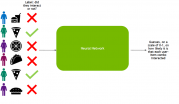 Recommender systems (RecSys) have become a key component in many online services, such as e-commerce, social media, news service, or online video streaming. However with the growth in importance, the growth in scale of industry datasets, and more sophisticated models, the bar has been raised for computational resources required for recommendation systems. To meet the … Continued
Recommender systems (RecSys) have become a key component in many online services, such as e-commerce, social media, news service, or online video streaming. However with the growth in importance, the growth in scale of industry datasets, and more sophisticated models, the bar has been raised for computational resources required for recommendation systems. To meet the … Continued
Recommender systems (RecSys) have become a key component in many online services, such as e-commerce, social media, news service, or online video streaming. However with the growth in importance, the growth in scale of industry datasets, and more sophisticated models, the bar has been raised for computational resources required for recommendation systems.
To meet the computational demands for large-scale DL recommender systems, NVIDIA introduced Merlin – a Framework for Deep Recommender Systems. Now NVIDIA teams have won two consecutive RecSys competitions in a row: the ACM RecSys Challenge 2020, and more recently the WSDM WebTour 21 Challenge organized by Booking.com. The Booking.com challenge focused on predicting the last city destination for a traveler’s trip given their previous booking history within the trip. NVIDIA’s interdisciplinary team included colleagues from NVIDIA’s KGMON (Kaggle Grandmasters), NVIDIA’s RAPIDS (Data Science), and NVIDIA’s Merlin (Recommender Systems) who collaborated on the winning solution.
This post is the second of a three-part series that gives an overview of the NVIDIA team’s first place solution for the booking.com challenge. The first post gives an overview of recommender system concepts. This second post discusses deep learning for recommender systems. The third post will discuss the winning solution, the steps involved, and also what made a difference in the outcome.
Deep Learning for Recommendation
As the growth in the volume of data available to power recommender systems accelerates rapidly, data scientists are increasingly turning from more traditional machine learning methods to highly expressive deep learning models to improve the quality of their recommendations.
Broadly, the life-cycle of deep learning for recommendation can be split into two phases: training and inference. In the training phase, the model is trained to predict user-item interaction probabilities (calculate a preference score) by presenting it with examples of interactions (or non-interactions) between users and items from the past.
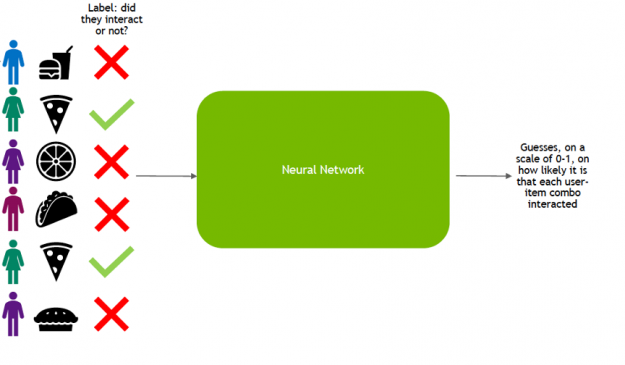
Once it has learned to make predictions with a sufficient level of accuracy, the model is deployed as a service to infer the likelihood of new interactions.
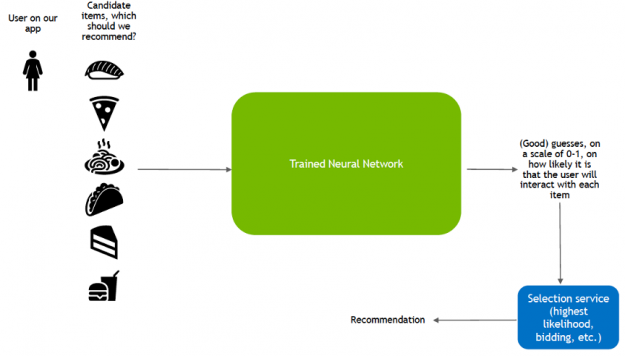
This inference stage utilizes a different pattern of data consumption than during training:
- Candidate generation: pair a user with hundreds or thousands of candidate items based on learned user-item similarity.
- Candidate ranking: rank the likelihood that the user enjoys each item.
- Filter: show the user the item they are rated most likely to enjoy.
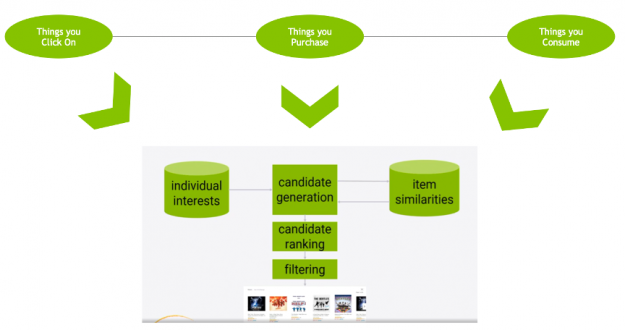
Deep Neural Network Models for Recommendation
Deep learning (DL) recommender models build upon existing techniques such as factorization to model the interactions between variables and embeddings to handle categorical variables. An embedding is a learned vector of numbers representing entity features so that similar entities (users or items) have similar distances in the vector space. For example, a deep learning approach to collaborative filtering learns the user and item embeddings (latent feature vectors) based on user and item interactions with a neural network.
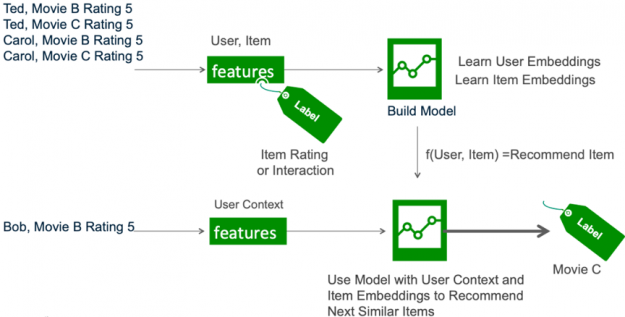
DL techniques also tap into the vast and rapidly growing novel network architectures and optimization algorithms to train on large amounts of data, use the power of deep learning for feature extraction, and build more expressive models. DL–based models build upon the different variations of artificial neural networks (ANNs), such as the following:
- Feedforward neural networks are ANNS where information is only fed forward from one layer to the next.
- Multilayer perceptrons (MLPs) are a type of feedforward ANN consisting of at least three layers of nodes: an input layer, a hidden layer, and an output layer. MLPs are flexible networks that can be applied to a variety of scenarios.
- Convolutional Neural Networks are the image crunchers to identify objects.
- Recurrent neural networks are the mathematical engines to parse language patterns and sequenced data.
GPUs, with their massively parallel architecture, are driving the advancement of deep learning (DL) and RecSys DL in the past several years. With GPUs, you can exploit data parallelism through columnar data processing instead of traditional row-based reading designed initially for CPUs. This provides higher performance and cost savings. Current DL–based models for recommender systems like DLRM, Wide and Deep (W&D), Neural Collaborative Filtering (NCF), Variational AutoEncoder (VAE) are part of the NVIDIA GPU-accelerated DL model portfolio that covers a wide range of network architectures and applications in many different domains beyond recommender systems, including image, text and speech analysis.
Neutral Collaborative Filtering
The Neural Collaborative Filtering (NCF) model is a neural network that provides collaborative filtering based on user and item interactions. The NCF model treats matrix factorization from a non-linearity perspective. NCF TensorFlow takes in a sequence of (user ID, item ID) pairs as inputs, then feeds them separately into a matrix factorization step (where the embeddings are multiplied) and into a multilayer perceptron (MLP) network.
The outputs of the matrix factorization and the MLP network are then combined and fed into a single dense layer which predicts whether the input user is likely to interact with the input item.

Variational Autoencoder for Collaborative Filtering
An autoencoder neural network reconstructs the input layer at the output layer by using the representation obtained in the hidden layer. An autoencoder for collaborative filtering learns a non-linear representation of a user-item matrix and reconstructs it by determining missing values.
The NVIDIA GPU-accelerated Variational Autoencoder for Collaborative Filtering (VAE-CF) is an optimized implementation of the architecture first described in Variational Autoencoders for Collaborative Filtering. VAE-CF is a neural network that provides collaborative filtering based on user and item interactions. The training data for this model consists of pairs of user-item IDs for each interaction between a user and an item.
The model consists of two parts: the encoder and the decoder. The encoder is a feedforward, fully connected neural network that transforms the input vector, containing the interactions for a specific user, into an n-dimensional variational distribution. This variational distribution is used to obtain a latent feature representation of a user (or embedding). This latent representation is then fed into the decoder, which is also a feedforward network with a similar structure to the encoder. The result is a vector of item interaction probabilities for a particular user.
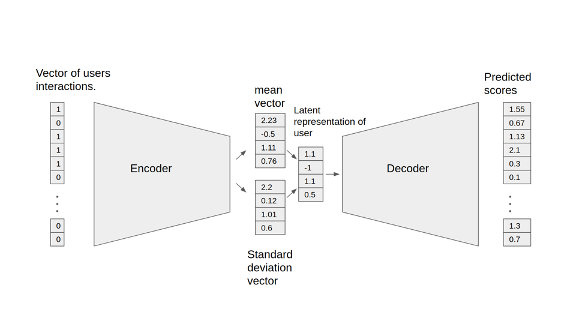
Wide and Deep
Wide & Deep refers to a class of networks that use the output of two parts working in parallel—wide model and deep model—whose outputs are summed to create an interaction probability. The wide model is a generalized linear model of features together with their transforms. The deep model is a Dense Neural Network (DNN), a series of hidden MLP layers, each beginning with a dense embedding of features. Categorical variables are embedded into continuous vector spaces before being fed to the DNN via learned or user-determined embeddings.

What makes this model so successful for recommendation tasks is that it provides two avenues of learning patterns in the data, “deep” and “shallow”. The complex, nonlinear DNN is capable of learning rich representations of relationships in the data and generalizing to similar items via embeddings but needs to see many examples of these relationships in order to do so well. The linear piece, on the other hand, is capable of “memorizing” simple relationships that may only occur a handful of times in the training set.
In combination, these two representation channels often end up providing more modeling power than either on its own. NVIDIA has worked with many industry partners who reported improvements in offline and online metrics by using Wide & Deep as a replacement for more traditional machine learning models.

DLRM
DLRM is a DL-based model for recommendations introduced by Facebook research. It’s designed to make use of both categorical and numerical inputs that are usually present in recommender system training data. To handle categorical data, embedding layers map each category to a dense representation before being fed into multilayer perceptrons (MLP). Numerical features can be fed directly into an MLP.
At the next level, second-order interactions of different features are computed explicitly by taking the dot product between all pairs of embedding vectors and processed dense features. Those pairwise interactions are fed into a top-level MLP to compute the likelihood of interaction between a user and item pair.
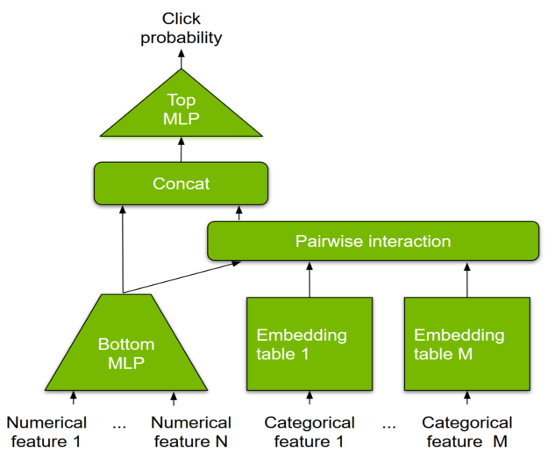
Compared to other DL-based approaches to recommendation, DLRM differs in two ways. First, it computes the feature interaction explicitly while limiting the order of interaction to pairwise interactions. Second, DLRM treats each embedded feature vector (corresponding to categorical features) as a single unit, whereas other methods (such as Deep and Cross) treat each element in the feature vector as a new unit that should yield different cross terms. These design choices help reduce computational/memory cost while maintaining competitive accuracy.
Contextual Sequence Learning
A Recurrent neural network (RNN) is a class of neural network that has memory or feedback loops that allow it to better recognize patterns in data. RNNs solve difficult tasks that deal with context and sequences, such as natural language processing, and are also used for contextual sequence recommendations. What distinguishes sequence learning from other tasks is the need to use models with an active data memory, such as LSTMs (Long Short-Term Memory) or GRU (Gated Recurrent Units) to learn temporal dependence in input data. This memory of past input is crucial for successful sequence learning. Transformer deep learning models, such as BERT (Bidirectional Encoder Representations from Transformers), are an alternative to RNNs that apply an attention technique—parsing a sentence by focusing attention on the most relevant words that come before and after it. Transformer-based deep learning models don’t require sequential data to be processed in order, allowing for much more parallelization and reduced training time on GPUs than RNNs.
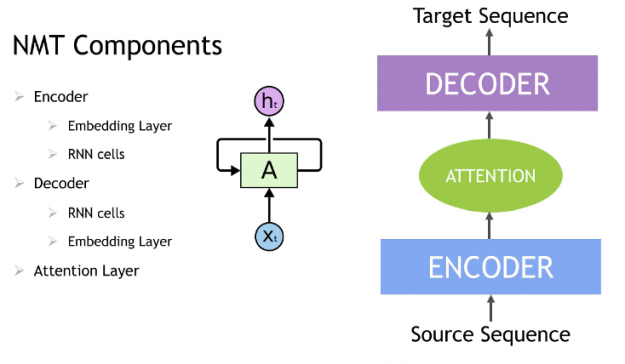
In an NLP application, input text is converted into word vectors using techniques, such as word embedding. With word embedding, each word in the sentence is translated into a set of numbers before being fed into RNN variants, Transformer, or BERT to understand context. These numbers change over time while the neural net trains itself, encoding unique properties such as the semantics and contextual information for each word, so that similar words are close to each other in this number space, and dissimilar words are far apart. These DL models provide an appropriate output for a specific language task like next-word prediction and text summarization, which are used to produce an output sequence.

Session-based recommendations apply the advances in sequence modeling from deep learning and NLP to recommendations. RNN models train on the sequence of user events in a session (e.g. products clicked, date and time of interactions) in order to predict the probability of a user clicking the candidate or target item. User item interactions in a session are embedded similarly to words in a sentence before being fed into RNN variants such as LSTM, GRU, or Transformer to understand the context. For example, Square’s deep learning-based product recommendation system shown below leverages the transformer-based model BERT, GRUs, and NVIDIA GPUs to create a vector representation of their sellers.
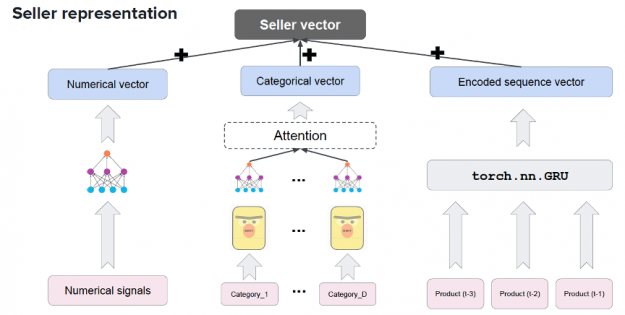
Alibaba also uses a model architecture with DNNs, GRUs and NVIDIA GPUs to support its e-commerce recommendation system which has a catalog of two billion products and can serve as many as 500 million customers per day.
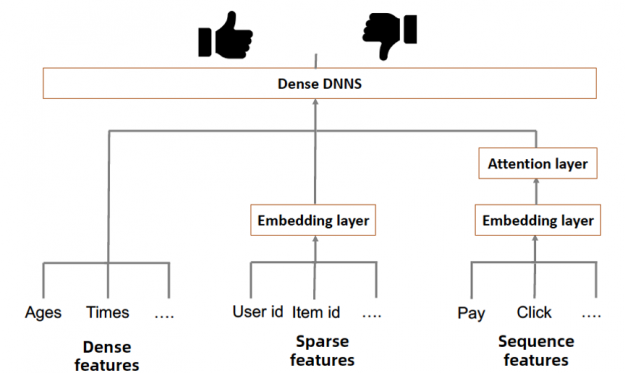
In the more detailed model diagram below, you can see that GRUs are added to learn and capture the relations among the items in the user behavior sequences in order to predict if a user will click on an advertised product.
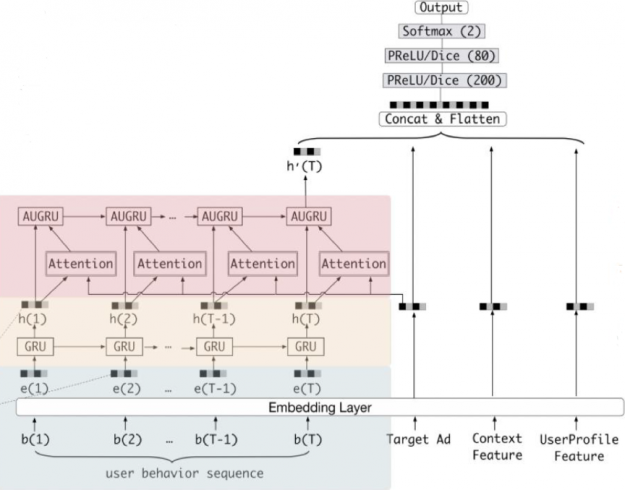
Alibaba is using thousands of T4 GPUs across its infrastructure with TensorRT to support the entire recommendation query AI pipeline on a real-time basis.
Session based recommender system architectures such as Alibaba’s Behavior Sequence Transformer follow the same general transformer architecture as for NLP, but model and embedding sizes between NLP and recommender systems vary significantly which means that you need to make sure that the entire recommendation AI pipeline is well tuned for the use case.
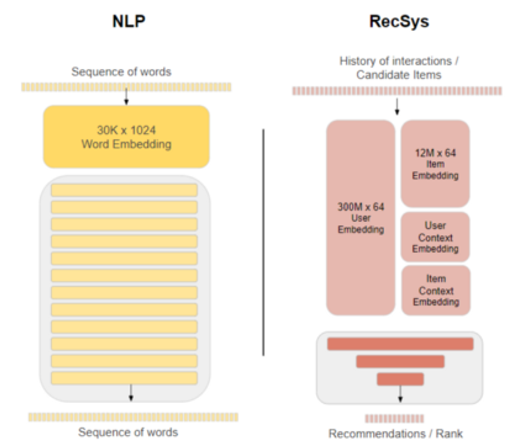
NVIDIA GPU Accelerated, End-to-End Data Science
NVIDIA developed RAPIDS —an open-source data analytics and machine learning acceleration platform—for executing end-to-end data science training pipelines completely in GPUs. It relies on NVIDIA® CUDA® primitives for low-level compute optimization, but exposes that GPU parallelism and high memory bandwidth through user-friendly Python interfaces.
—an open-source data analytics and machine learning acceleration platform—for executing end-to-end data science training pipelines completely in GPUs. It relies on NVIDIA® CUDA® primitives for low-level compute optimization, but exposes that GPU parallelism and high memory bandwidth through user-friendly Python interfaces.
Focusing on common data preparation tasks for analytics and data science, RAPIDS offers a GPU-accelerated DataFrame (cuDF) that mimics the pandas API and is built on Apache Arrow. It integrates with scikit-learn and a variety of machine learning algorithms to maximize interoperability and performance without paying typical serialization costs. This allows acceleration for end-to-end pipelines—from data prep to machine learning to deep learning. RAPIDS also includes support for multi-node, multi-GPU deployments, enabling vastly accelerated processing and training on much larger dataset sizes.
Compared to similar CPU-based implementations, RAPIDS delivers 50x performance improvements for classical data analytics and machine learning (ML) processes at scale which drastically reduces the total cost of ownership (TCO) for large data science operations.
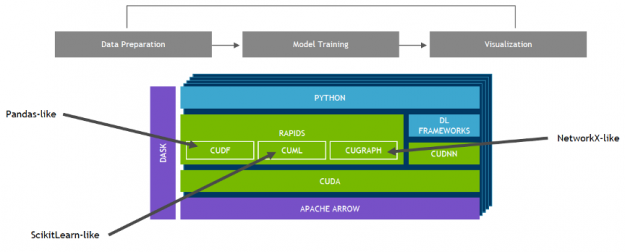
NVIDIA Merlin
NVIDIA Merlin is an open-source application framework for building high-performance, DL–based recommender systems, built on NVIDIA RAPIDS , NVIDIA CUDA® Deep Neural Network library (cuDNN), and Triton. Merlin facilitates and accelerates recommender systems on GPU, speeding up common ETL tasks, training of models, and inference serving by ~10x over commonly used methods.
, NVIDIA CUDA® Deep Neural Network library (cuDNN), and Triton. Merlin facilitates and accelerates recommender systems on GPU, speeding up common ETL tasks, training of models, and inference serving by ~10x over commonly used methods.
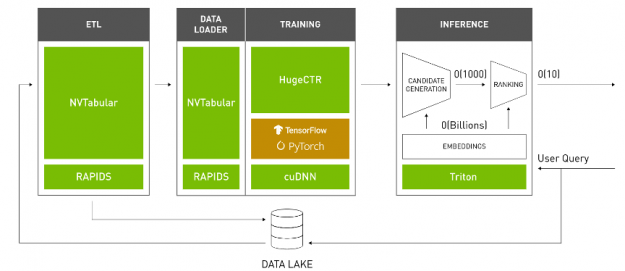
NVTabular is a feature engineering and preprocessing library for recommender systems. It provides a high-level abstraction to simplify code and accelerates computation on the GPU using the RAPIDS GPU-accelerated DataFrame cuDF library.

HugeCTR is a GPU-accelerated deep neural network training framework designed to distribute training across multiple GPUs and nodes. It supports state-of-the-art hybrid model-parallel embedding tables and data-parallel neural networks and their variants, such as Wide and Deep Learning (WDL), Deep Cross Network (DCN), DeepFM, xDeepFM, Variational Autoencoder (VAE), and Deep Learning Recommendation Model (DLRM).
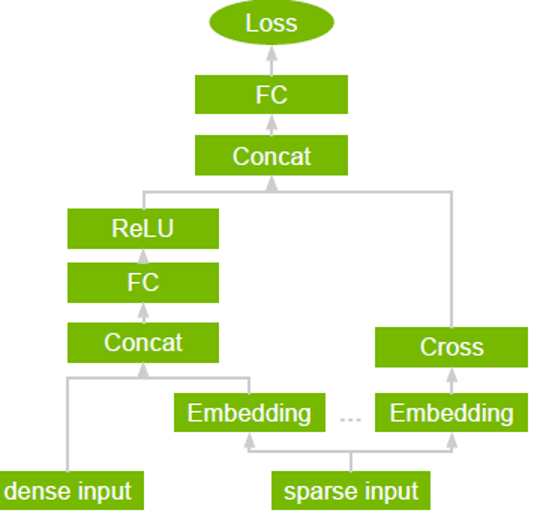
NVIDIA Triton Inference Server and NVIDIA® TensorRT
Inference Server and NVIDIA® TensorRT accelerate production inference on GPUs for feature transforms and neural network execution.
accelerate production inference on GPUs for feature transforms and neural network execution.
Beyond providing better performance, these libraries are also designed to be easy to use and integrate with existing recommendation pipelines.
Conclusion
In this blog, we gave an overview of deep learning models for recommender systems. Part three will discuss the NVIDIA teams’ winning solution for the ACM WSDM WebTour 21 Challenge organized by Booking.com.
Next steps
- Go to the Merlin home page
- Read:
- Introduction to NVIDIA Merlin
- Like Magic: NVIDIA Merlin Gains Adoption for Training and Inference
- Accelerated Wide and Deep Pipeline
- Building Recommender Systems Faster Using Jupyter Notebooks from NGC
- Optimizing the Deep Learning Recommendation Model on NVIDIA GPUs
- NVIDIA Merlin Accelerates Recommender Workflows with .4 Release
- Achieving High-Quality Search and Recommendation Results with DeepNLP
- NVIDIA GPUs Accelerate World’s Biggest Online Shopping Event
- Watch GTC sessions: NVIDIA Deepens Commitment to Streamlining Recommender Workflows with GTC Spring Sessions
- NVIDIA Deep Learning Institute: Building Intelligent Recommender Systems
People are able to retrieve the visual information about 3D environments from a picture quite easily — we can identify objects, determine instance sizes, and reconstruct 3D scene layout, all using the limited signals contained in 2D images. This ability is commonly known as the inverse projection problem, which refers to reconstructing the ambiguous mapping from the retinal images to the sources of retinal stimulation. Real-world computer vision applications, such as autonomous driving, heavily rely on these capabilities to localize and identify 3D objects, which require vision models to infer the spatial location, semantic class, and instance label for each 3D point projected to the 2D images. The ability to reconstruct the 3D world from images can be decomposed into two disjoint computer vision tasks: monocular depth estimation (predicting depth from a single image) and video panoptic segmentation (the unification of instance segmentation and semantic segmentation, in the video domain). However, research has generally considered each task separately. Tackling these tasks jointly with a unified computer vision model could result in easier deployment and greater efficiency by sharing computation among multiple tasks.
Driven by the potential value of a model that predicts depth and video panoptic segmentation at the same time, we present “ViP-DeepLab: Learning Visual Perception with Depth-aware Video Panoptic Segmentation”, accepted to CVPR 2021. In this work, we propose a new task, depth-aware video panoptic segmentation, that aims to simultaneously tackle monocular depth estimation and video panoptic segmentation. For the new task, we present two derived datasets accompanied by a new evaluation metric called depth-aware video panoptic quality (DVPQ). This new metric includes the metrics for depth estimation and video panoptic segmentation, requiring a vision model to simultaneously tackle the two sub-tasks. To this end, we extend Panoptic-DeepLab by adding network branches for depth and video predictions to create ViP-DeepLab, a unified model that jointly performs video panoptic segmentation and monocular depth estimation for each pixel on the image plane, and achieves state-of-the-art performance on several academic datasets for the sub-tasks. This video demonstrates the new task and shows the results of ViP-DeepLab.
 |
| Depth-aware video panoptic segmentation results obtained by ViP-DeepLab. Top-left: Video frames used as input. Top-right: Video panoptic segmentation results. Bottom-left: Estimated depth. Bottom-right: Reconstructed 3D points. Each object instance has a unique and temporally consistent label, e.g., pedestrain_1, pedestrain_2, etc. Input images are from the Cityscapes dataset. |
Overview
While Panoptic-DeepLab is able to output semantic segmentation, center prediction, and center regression for a single frame, it lacks the capability of depth estimation and temporally consistent instance ID prediction for multiple frames. However, ViP-DeepLab accomplishes this by performing additional predictions from two consecutive frames as input. The first additional output is depth estimation for the first frame, for which it assigns an estimated depth to each pixel. In addition, ViP-DeepLab also performs center regression for two consecutive frames for only the object centers that appear in the first frame. This process is called center offset prediction, and allows ViP-DeepLab to group all the pixels in the two frames to the same object that appears in the first frame. New instances emerge if they are not grouped to the previously detected instances. This process continues for every two consecutive frames (with one overlapping frame) in a video sequence, stitching panoptic predictions together to form predictions with temporally consistent instance IDs. That is, it stitches together where objects are and how they move in a video scene with time.
 |
| Outputs of ViP-DeepLab for video panoptic segmentation. Two consecutive frames are concatenated as input. The semantic segmentation output associates each pixel with its semantic classes, while the instance segmentation outputs identify the pixels from two frames associated with an individual object in the first frame. Input images are from the Cityscapes dataset. |
 |
| Visualization of stitching video panoptic predictions. ViP-DeepLab propagates IDs based on mask intersection-over-union between region pairs. It is capable of tracking objects with large movements, e.g., the cyclist in the image. |
Neural Network Design
Building on top of Panoptic-DeepLab, ViP-DeepLab additionally contains two prediction branches: (1) a depth prediction branch, and (2) a next-frame instance branch. Specifically, the depth prediction head is a simple design that predicts depth regression for every pixel, while the next-frame instance branch predicts the center offsets for the pixels in the second frame with respect to the centers in the first frame.
Results
We have tested ViP-DeepLab on multiple popular benchmarks, including Cityscapes-VPS, KITTI Depth Prediction, and KITTI Multi-Object Tracking and Segmentation (MOTS).
Specifically, ViP-DeepLab achieves state-of-the-art (SOTA) results, significantly outperforming previous methods by 5.1% video panoptic quality (VPQ) on the Cityscapes-VPS test set.
| Method | VPQAll | VPQThings | VPQStuff |
| VPSNet | 57.4% | 45.8% | 64.8% |
| ViP-DeepLab | 62.5% (+5.1%) | 50.2% (+4.4%) | 70.3% (+5.5%) |
| VPQ comparison on Cityscapes-VPS test set. |
ViP-DeepLab ranks 1st on the KITTI depth prediction benchmark, improving over previous methods by 0.65 SILog (the smaller the better).
| Method | SILog | sqErrorRel | absErrorRel | iRMSE |
| PWA | 11.45 | 2.30 | 9.05 | 12.32 |
| ViP-DeepLab | 10.80 | 2.19 | 8.94 | 11.77 |
| Monocular depth estimation comparison on KITTI Depth Prediction benchmark. Note for the depth estimation metrics, the smaller the values, the better the performance. While differences may appear small, the top-performing method on this benchmark usually has a gap in SILog smaller than 0.1. |
Additionally, ViP-DeepLab was also 1st on KITTI MOTS pedestrians and 3rd on KITTI MOTS cars ranked by the metric sMOTSA, and now is 3rd for both pedestrians and cars ranked by a newer metric HOTA.
| Class | Method | HOTA |
| Car | PointTrack | 62.0% |
| ViP-DeepLab | 76.4% (+14.4%) | |
| Pedestrian | PointTrack | 54.4% |
| ViP-DeepLab | 64.3% (+9.9%) |
| Performance comparison on KITTI Multi-Object Tracking and Segmentation. |
Finally, we also present two new datasets for the new task, depth-aware video panoptic segmentation, and test ViP-DeepLab on them. We hope our ViP-DeepLab results on these two new datasets will serve as a strong baseline for the community to compare against. The results are shown below.
| Dataset | DVPQAll | DVPQThings | DVPQStuff |
| Cityscapes-DVPS | 55.1% | 43.3% | 63.6% |
| SemKITTI-DVPS | 45.6% | 36.6% | 52.2% |
| ViP-DeepLab performance for the task of depth-aware video panoptic segmentation on two new datasets. |
Conclusion
With a simple architecture, ViP-DeepLab achieves state-of-the-art performance on video panoptic segmentation, monocular depth estimation, and multi-object tracking and segmentation. We hope that along with MaX-DeepLab, which proposes an efficient dual-path transformer module that allows for end-to-end image panoptic segmentation, ViP-DeepLab is useful to the community and furthers research into a more holistic understanding of scenes in the real world.
Acknowledgements
We would like to thank the support and valuable discussions with Yukun Zhu, Hartwig Adam, and Alan Yuille (co-authors of ViP-DeepLab), as well as Maxwell Collins, and the Mobile Vision team.
 Google Cloud and NVIDIA collaborated to make MLOps simple, powerful, and cost-effective by bringing together the solution elements to build, serve and dynamically scale your end-to-end ML pipelines with the right-sized GPU acceleration in one place.
Google Cloud and NVIDIA collaborated to make MLOps simple, powerful, and cost-effective by bringing together the solution elements to build, serve and dynamically scale your end-to-end ML pipelines with the right-sized GPU acceleration in one place. 
Building, deploying, and managing end-to-end ML pipelines in production, particularly for applications like recommender systems is challenging. Operationalizing ML models, within enterprise applications, to deliver business value involves a lot more than developing the machine learning algorithms and models themselves – it’s a continuous process of data collection and preparation, model building, training or retraining with newer data, model validation, inference serving, and monitoring model performance to ensure the relevance of the results.
In addition to the challenge of developing the pipeline, you also need to secure and manage the right compute infrastructure to accelerate these steps for a guaranteed quality-of-service (QoS) for your customers. And, each step in the pipeline is unique too so your compute requirements for data preparation and training might be completely different from what’s required to service multiple disparate inference requests. This is both a development and infrastructure management challenge also commonly referred to as the MLOps challenge.
Google Cloud and NVIDIA have collaborated to make MLOps simple, powerful, and cost-effective by bringing together the solution elements to build, serve and dynamically scale your end-to-end ML pipelines with the right-sized GPU acceleration in one place. You can focus on delivering the best value for your end customers while maximizing infrastructure utilization and minimizing operational costs for deploying your AI-enabled services.
GKE + MIG = Portability, Scalability & Productivity for MLOps
Google Kubernetes Engine (GKE) is a managed environment for deploying, scaling and managing containerized ML applications in a secure Google infrastructure. GKE facilitates easy cluster creation, load balancing, autoscaling compute requirements based on demand among other things. Most importantly GKE frees up users from having to manage their own workstations, servers, and VMs while building and deploying ML pipelines – you can focus on the most important value-add tasks of building and training your ML models for your business use-case.
The Google Kubernetes Engine (GKE) now supports the Multi-Instance GPU (MIG) feature enabling each NVIDIA A100 Tensor Core GPU in the new A2 VM instance to be partitioned into as many as seven independent GPU instances, each with its own high-bandwidth memory, cache, and compute cores. GKE can then provision GPU resources for your workloads with greater granularity, share a single GPU for multi-user, multi-model use-cases and automatically scale up or down based on changing needs of your ML pipelines.
For example, GKE can provision multiple A100 GPU MIG instances to process inference requests for multiple models to be simultaneously executed on the independent MIG partitions within a single A100 GPU to maximize utilization. As the compute required for your deployed ML pipelines increase (e.g. a sudden surge in inference requests to service), GKE can automatically scale to additional node-pools with MIG partitions. In addition, the NVIDIA Collective Communication Library (NCCL) further optimizes multi-GPU, multi-node communications within the GKE cluster to ensure high bandwidth, high throughput, and low latency.
NVIDIA Solution Stack to Develop & Deploy End-to-End Machine Learning Pipelines
To develop ML application pipelines that are scalable and are optimized to leverage the full benefits of the MIG capabilities for GPU utilization on Google Cloud, NVIDIA offers several GPU-accelerated end-to-end application-specific frameworks – NVIDIA Merlin for end-to-end recommendation systems, NVIDIA Jarvis for multimodal conversational AI services, and NVIDIA RAPIDS for data analytics pipelines. All NVIDIA optimized frameworks, SDKs, pre-trained models, and performance-optimized libraries can be accessed from NGC Catalog, a hub for GPU-accelerated software.
Deploying the ML pipelines into production at scale on a GKE managed cluster is further simplified with NVIDIA Triton Inference Server software. This open-source inference serving software lets teams deploy trained AI models from any framework (TensorFlow, TensorRT, PyTorch, ONNX Runtime, or a custom framework), from local storage or Google Cloud’s managed storage products on any GPU- or CPU-based infrastructure. Triton Inference Server software is now directly available on the GCP Marketplace to seamlessly deploy, serve, monitor performance and dynamically scale multiple AI inference requests on MIG-enabled GKE clusters.
Bringing it All Together
GKE’s managed Kubernetes services combined with the flexibility of the A100 MIG feature and NVIDIA’s GPU-optimized solution stack for accelerating ML pipelines helps address both the development and infrastructure management challenges of productizing end-to-end ML pipelines.
To see these technologies in action with a real example, check out this GTC21 Session – “Gain Competitive Advantage using MLOps: Kubeflow and NVIDIA Merlin and Google Cloud” to learn how GKE, NVIDIA A100 MIG, and NVIDIA’s GPU-optimized solution stack can be used to build and deploy an end-to-end recommender system.
Run a GitHub project on google Colabratory
[removed]
submitted by /u/richard-romex
[visit reddit] [comments]
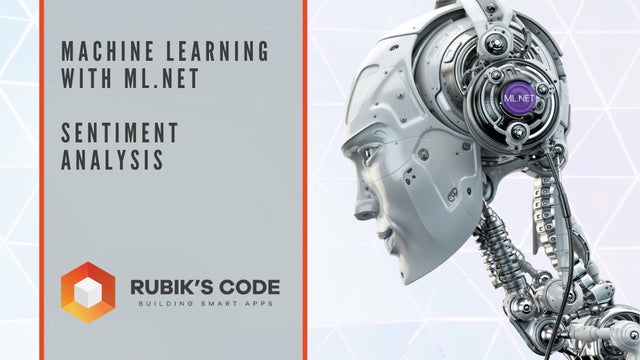
|
submitted by /u/RubiksCodeNMZ [visit reddit] [comments] |
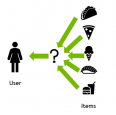 Recommender systems (RecSys) have become a key component in many online services, such as e-commerce, social media, news service, or online video streaming. However with their growth in importance, the growth in scale of industry datasets, and more sophisticated models, the bar has been raised for computational resources required for recommendation systems. After NVIDIA introduced Merlin … Continued
Recommender systems (RecSys) have become a key component in many online services, such as e-commerce, social media, news service, or online video streaming. However with their growth in importance, the growth in scale of industry datasets, and more sophisticated models, the bar has been raised for computational resources required for recommendation systems. After NVIDIA introduced Merlin … Continued
Recommender systems (RecSys) have become a key component in many online services, such as e-commerce, social media, news service, or online video streaming. However with their growth in importance, the growth in scale of industry datasets, and more sophisticated models, the bar has been raised for computational resources required for recommendation systems.
After NVIDIA introduced Merlin – a Framework for Deep Recommender Systems – to meet the computational demands for large-scale DL recommender systems, and a NVIDIA team won the ACM RecSys Challenge 2020, now a NVIDIA team has won the WSDM WebTour 21 Challenge organized by Booking.com. The Booking.com challenge focused on predicting the last city destination for a traveler’s trip given their previous booking history within the trip. NVIDIA’s interdisciplinary team included colleagues from NVIDIA’s KGMON (Kaggle Grandmasters), NVIDIA’s RAPIDS (Data Science), and NVIDIA’s Merlin (Recommender Systems) who collaborated on the winning solution.
This post is the first of a three-part series that gives an overview of the NVIDIA team’s first place solution for the booking.com challenge. This first post gives an overview of recommender system concepts. The second post will discuss deep learning for recommender systems. The third post will discuss the winning solution, the steps involved, and also what made a difference in the outcome.
What is a Recommendation System?
Recommender systems are trained to understand the preferences, previous decisions, and characteristics of people and products, using data gathered about their interactions, which include impressions, clicks, likes, and purchases. Recommender systems help solve information overload by helping users find relevant products from a wide range of selections by providing personalized content. Because of their capability to predict consumer interests and desires on a highly personalized level, recommender systems are a favorite with content and product providers because they drive consumers to just about any product or service that interests them, from books to videos to health classes to clothing.
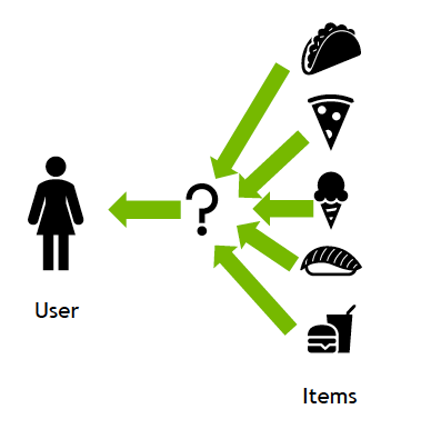
Types of Recommendation Systems
Traditionally, recommender systems approaches could be divided into these broad categories: collaborative filtering, content filtering, and hybrid recommenders systems. More recently, some variations have been proposed to leverage explicitly the user context (context-aware recommendation), the sequence of user interactions (sequential recommendation) and the interactions of the current user session for next-click prediction (session-based recommendation).
Collaborative filtering algorithms recommend items (this is the filtering part) based on preference information from many users (this is the collaborative part). This approach uses similarity of user preference behavior, given previous interactions between users and items, recommender algorithms learn to predict future interaction. These recommender systems build a model from a user’s past behavior, such as items purchased previously or ratings given to those items and similar decisions by other users. The idea is that if some people have made similar decisions and purchases in the past, like a movie choice, then there is a high probability they will agree on additional future selections. For example, if a collaborative filtering recommender knows you and another user share similar tastes in movies, it might recommend a movie to you that it knows this other user already likes.
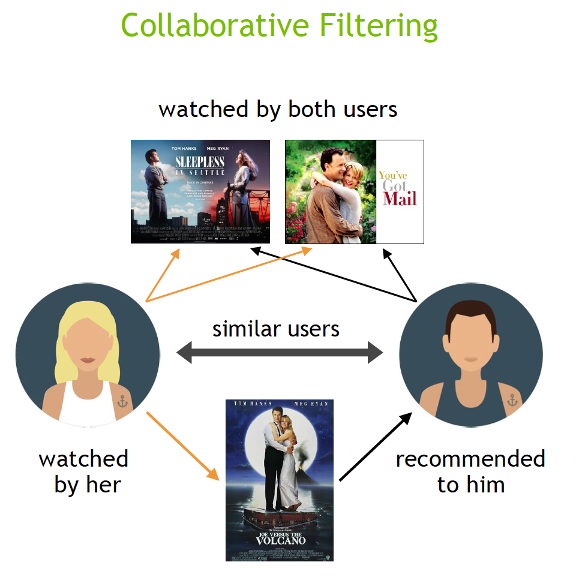
Content filtering, by contrast, uses the attributes or features of an item (this is the content part) to recommend other items similar to the user’s preferences. This approach is based on similarity of items and user features, given information about a user and items they have interacted with, (e.g. a user’s demographics, like age or gender, the category of a restaurant’s cuisine, the average review for a movie), model the likelihood of a new interaction. For example, if a content filtering recommender sees you liked the movies “You’ve Got Mail” and “Sleepless in Seattle,” it might recommend another movie to you with the same genres and/or cast, such as “Joe Versus the Volcano.”

Collaborative filtering is straightforward to apply, as it only requires as input the user id and item id for each interaction. However, it requires a minimum number of interactions by user and by item before starting to provide meaningful recommendations, which is characterized as the cold-start problem. On the other hand, as content-based filtering only leverages the interactions of each user, it deals nicely with the user cold-start problem. But it tends to create a filter bubble, recommending only items very similar to those the user has interacted with before.
Hybrid recommender systems combine the advantages of the types above to create a more comprehensive recommending system.
Session or sequence-based recommender systems use the sequence of user item interactions within a session in the recommendation process. Examples include predicting the next item in an online shopping cart, the next video to watch, or in the booking.com example, the next travel destination of a traveler.
Netflix spoke at NVIDIA GTC about making better recommendations by framing a recommendation as a contextual sequence prediction. Their approach uses a sequence of user actions, plus the current context, to predict the probability of the next action. In the Netflix example, given one sequence for each user—the country, device, date, and time when they watched a movie—they trained a model to predict what to watch next.
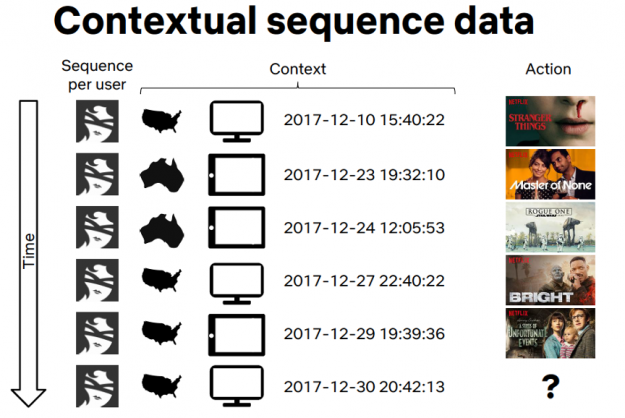
How Recommenders Work
Recommender systems are trained using data gathered about the users, items, and their interactions, which include impressions, clicks, likes, mentions, and so on. How a recommender model makes recommendations will depend on the type of data you have. If you only have data about which interactions have occurred in the past, you’ll probably be interested in collaborative filtering. If you have data describing the user and items they have interacted with (e.g. a user’s age, the category of a restaurant’s cuisine, the average review for a movie), you can model the likelihood of a new interaction given these properties at the current moment by adding content and context filtering.
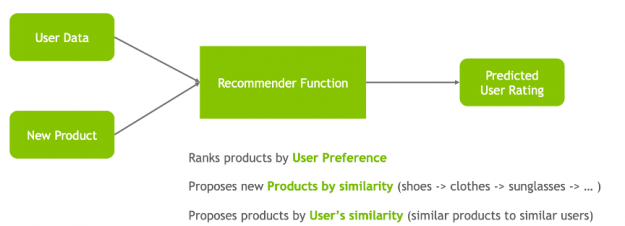
Matrix Factorization for Recommendation
Matrix factorization (MF) techniques are the core of many popular algorithms, including word embedding and topic modeling, and have become a dominant methodology within the collaborative-filtering-based recommendations. MF can be used to calculate the similarity in user’s ratings or interactions to provide recommendations. In the simple user-item matrix below, Ted and Carol like movies B and C. Bob likes movie B. To recommend a movie to Bob, matrix factorization calculates that users who liked B also liked C, so C is a possible recommendation for Bob.
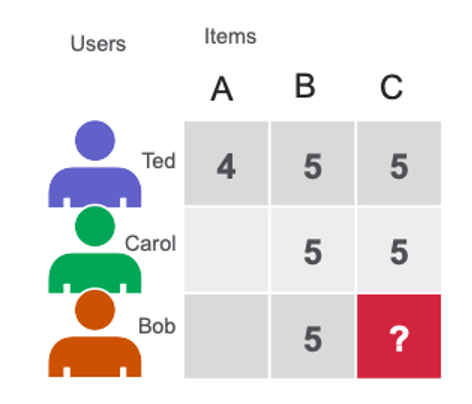
Matrix factorization using the alternating least squares (ALS) algorithm approximates the sparse user item rating matrix u-by-i as the product of two dense matrices, user and item factor matrices of size u × f and f × i (where u is the number of users, i the number of items and f the number of latent features) . The factor matrices represent latent or hidden features which the algorithm tries to discover. One matrix tries to describe the latent or hidden features of each user, and one tries to describe latent properties of each movie. For each user and for each item, the ALS algorithm iteratively learns (f) numeric “factors” that represent the user or item. In each iteration, the algorithm alternatively holds one factor matrix fixed and optimizes for the other by minimizing the loss function with respect to the other. This process continues until it converges.
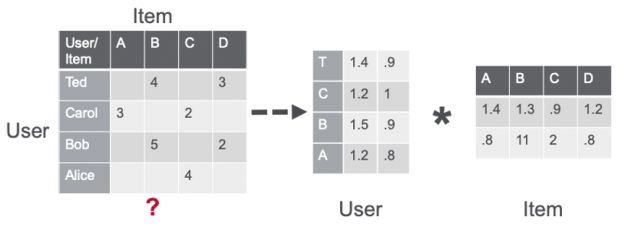
Conclusion
In this blog, we gave an overview of recommender system concepts and matrix factorization. In part two we will go over deep learning models for recommender systems and in part three we will go over the booking.com winning solution. To learn more, be sure to:
- Read the blog: What’s a Recommender System?
- Read the blog: Accelerating ETL for Recommender Systems on NVIDIA GPUs with NVTabular
- Listen to the on demand session: Scalable GPU-Accelerated Recommender Systems
- Listen to the GTC sessions: NVIDIA Deepens Commitment to Streamlining Recommender Workflows with GTC Spring Sessions
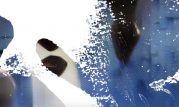 A recent National Poetry Month feature in The Washington Post presented AI-generated artwork alongside five original poems reflecting on seasons of the past year.
A recent National Poetry Month feature in The Washington Post presented AI-generated artwork alongside five original poems reflecting on seasons of the past year. 
A recent National Poetry Month feature in The Washington Post presented AI-generated artwork alongside five original poems reflecting on seasons of the past year.
Created by the Lede Lab — an experimental news team at The Post dedicated to exploring emerging technologies and new storytelling techniques — the artwork combined the output of machine learning models including NVIDIA StyleGAN2. Developed by NVIDIA Research, StyleGAN is a popular AI for high-res image generation that’s been adopted for art exhibits, manga illustrations and reimagined historical portraits.
Running on NVIDIA GPUs in the cloud, StyleGAN2 was trained on scanned images of brush strokes and palette knife textures painted by the group’s designer, Shikha Subramaniam.
The team also used the open-source AttnGAN model to create generative art that responded line by line to each of the five commissioned poems in the piece. Combined, the outputs from both models created a series of abstract videos to accompany the text.
As readers scroll through the interactive feature, the dynamic AI-generated artwork morphs to reflect each line of the poems — in one case shifting from colorful to monochrome and back again.
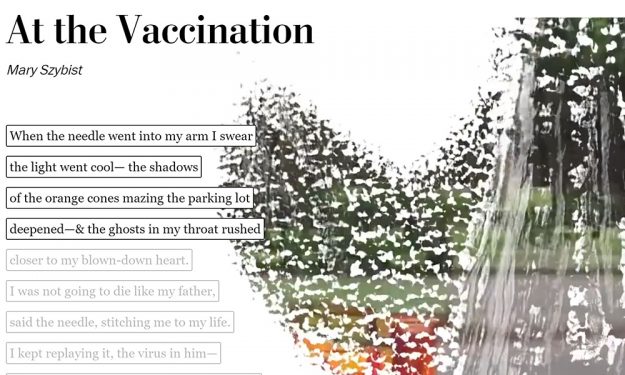
“Anxiously watching the coronavirus spread across the globe, we missed sharing so much with others, including the four seasons with their shifts in color and temperature,” wrote Suzette Moyer, senior design editor at The Post. The poems — authored by Mary Szybist, Dorianne Laux, Ada Limón, Kazim Ali and Willie Perdomo — are “hopeful works about the seasons we missed and the days we can look forward to.”
View the interactive piece in The Post >>
For more AI-inspired artwork, visit the AI Art Gallery featured at the recent NVIDIA GPU Technology Conference.
submitted by /u/jben_hun
[visit reddit] [comments]
Crop bounding box from an image
import tensorflow as tf
physical_devices = tf.config.experimental.list_physical_devices(‘GPU’)
if len(physical_devices) > 0:
tf.config.experimental.set_memory_growth(physical_devices[0], True)
from absl import app, flags, logging
from absl.flags import FLAGS
import core.utils as utils
from core.yolov4 import filter_boxes
from tensorflow.python.saved_model import tag_constants
from PIL import Image
import cv2
import numpy as np
from tensorflow.compat.v1 import ConfigProto
from tensorflow.compat.v1 import InteractiveSession
flags.DEFINE_string(‘framework’, ‘tf’, ‘(tf, tflite, trt’)
flags.DEFINE_string(‘weights’, ‘./checkpoints/yolov4-416’,
‘path to weights file’)
flags.DEFINE_integer(‘size’, 416, ‘resize images to’)
flags.DEFINE_boolean(‘tiny’, False, ‘yolo or yolo-tiny’)
flags.DEFINE_string(‘model’, ‘yolov4’, ‘yolov3 or yolov4’)
flags.DEFINE_string(‘image’, ‘./data/kite.jpg’, ‘path to input image’)
flags.DEFINE_string(‘output’, ‘result.png’, ‘path to output image’)
flags.DEFINE_float(‘iou’, 0.45, ‘iou threshold’)
flags.DEFINE_float(‘score’, 0.25, ‘score threshold’)
def main(_argv):
config = ConfigProto()
config.gpu_options.allow_growth = True
session = InteractiveSession(config=config)
STRIDES, ANCHORS, NUM_CLASS, XYSCALE = utils.load_config(FLAGS)
input_size = FLAGS.size
image_path = FLAGS.image
original_image = cv2.imread(image_path)
original_image = cv2.cvtColor(original_image, cv2.COLOR_BGR2RGB)
# image_data = utils.image_preprocess(np.copy(original_image), [input_size, input_size])
image_data = cv2.resize(original_image, (input_size, input_size))
image_data = image_data / 255.
# image_data = image_data[np.newaxis, …].astype(np.float32)
images_data = []
for i in range(1):
images_data.append(image_data)
images_data = np.asarray(images_data).astype(np.float32)
if FLAGS.framework == ‘tflite’:
interpreter = tf.lite.Interpreter(model_path=FLAGS.weights)
interpreter.allocate_tensors()
input_details = interpreter.get_input_details()
output_details = interpreter.get_output_details()
print(input_details)
print(output_details)
interpreter.set_tensor(input_details[0][‘index’], images_data)
interpreter.invoke()
pred = [interpreter.get_tensor(output_details[i][‘index’]) for i in range(len(output_details))]
if FLAGS.model == ‘yolov3’ and FLAGS.tiny == True:
boxes, pred_conf = filter_boxes(pred[1], pred[0], score_threshold=0.25, input_shape=tf.constant([input_size, input_size]))
else:
boxes, pred_conf = filter_boxes(pred[0], pred[1], score_threshold=0.25, input_shape=tf.constant([input_size, input_size]))
else:
saved_model_loaded = tf.saved_model.load(FLAGS.weights, tags=[tag_constants.SERVING])
infer = saved_model_loaded.signatures[‘serving_default’]
batch_data = tf.constant(images_data)
pred_bbox = infer(batch_data)
for key, value in pred_bbox.items():
boxes = value[:, :, 0:4]
pred_conf = value[:, :, 4:]
boxes, scores, classes, valid_detections = tf.image.combined_non_max_suppression(
boxes=tf.reshape(boxes, (tf.shape(boxes)[0], -1, 1, 4)),
scores=tf.reshape(
pred_conf, (tf.shape(pred_conf)[0], -1, tf.shape(pred_conf)[-1])),
max_output_size_per_class=50,
max_total_size=50,
iou_threshold=FLAGS.iou,
score_threshold=FLAGS.score
)
pred_bbox = [boxes.numpy(), scores.numpy(), classes.numpy(), valid_detections.numpy()]
image = utils.draw_bbox(original_image, pred_bbox)
image = Image.fromarray(image.astype(np.uint8))
image.show()
image = cv2.cvtColor(np.array(image), cv2.COLOR_BGR2RGB)
cv2.imwrite(FLAGS.output, image)
if __name__ == ‘__main__’:
try:
app.run(main)
except SystemExit:
pass
PLZ HELP ME CROP THE BOUNDING BOX IN ORDER TO PERFORM A TESSERACT TO READ WHAT IS INSIDE THE BOUNDING BOX (DIGITS) .This is my work but it doesn’t crop
import tensorflow as tf
physical_devices = tf.config.experimental.list_physical_devices(‘GPU’)
if len(physical_devices) > 0:
tf.config.experimental.set_memory_growth(physical_devices[0], True)
from absl import app, flags, logging
from absl.flags import FLAGS
import core.utils as utils
from core.yolov4 import filter_boxes
from tensorflow.python.saved_model import tag_constants
from PIL import Image
import cv2
import numpy as np
import os
from tensorflow.compat.v1 import ConfigProto
from tensorflow.compat.v1 import InteractiveSession
flags.DEFINE_string(‘framework’, ‘tf’, ‘(tf, tflite, trt’)
flags.DEFINE_string(‘weights’, ‘./checkpoints/yolov4-416’,
‘path to weights file’)
flags.DEFINE_integer(‘size’, 416, ‘resize images to’)
flags.DEFINE_boolean(‘tiny’, False, ‘yolo or yolo-tiny’)
flags.DEFINE_string(‘model’, ‘yolov4’, ‘yolov3 or yolov4’)
flags.DEFINE_string(‘image’, ‘./data/kite.jpg’, ‘path to input image’)
flags.DEFINE_string(‘output’, ‘result.png’, ‘path to output image’)
flags.DEFINE_float(‘iou’, 0.45, ‘iou threshold’)
flags.DEFINE_float(‘score’, 0.25, ‘score threshold’)
flags.DEFINE_boolean(‘crop’, False, ‘crop detections from images’)
def crop_objects (img, data, path){
boxes, scores = data
class_name = “Compteur”
# get box coords
xmin, ymin, xmax, ymax = boxes[i]
# crop detection from image (take an additional 5 pixels around all edges)
cropped_img = img[int(ymin)-5:int(ymax)+5, int(xmin)-5:int(xmax)+5]
# construct image name and join it to path for saving crop properly
img_name = class_name +’.png’
img_path = os.path.join(path, img_name )
# save image
cv2.imwrite(img_path, cropped_img)
}
# helper function to convert bounding boxes from normalized ymin, xmin, ymax, xmax —> xmin, ymin, xmax, ymax
def format_boxes(bboxes, image_height, image_width):
for box in bboxes:
ymin = int(box[0] * image_height)
xmin = int(box[1] * image_width)
ymax = int(box[2] * image_height)
xmax = int(box[3] * image_width)
box[0], box[1], box[2], box[3] = xmin, ymin, xmax, ymax
return bboxes
def draw_bbox(image, bboxes, info = False, counted_classes = None, show_label=True, allowed_classes=list(read_class_names(cfg.YOLO.CLASSES).values()), read_plate = False):
classes = read_class_names(cfg.YOLO.CLASSES)
num_classes = len(classes)
image_h, image_w, _ = image.shape
hsv_tuples = [(1.0 * x / num_classes, 1., 1.) for x in range(num_classes)]
colors = list(map(lambda x: colorsys.hsv_to_rgb(*x), hsv_tuples))
colors = list(map(lambda x: (int(x[0] * 255), int(x[1] * 255), int(x[2] * 255)), colors))
random.seed(0)
random.shuffle(colors)
random.seed(None)
out_boxes, out_scores, out_classes, num_boxes = bboxes
for i in range(num_boxes):
if int(out_classes[i]) < 0 or int(out_classes[i]) > num_classes: continue
coor = out_boxes[i]
fontScale = 0.5
score = out_scores[i]
class_ind = int(out_classes[i])
class_name = classes[class_ind]
if class_name not in allowed_classes:
continue
else:
if read_plate:
height_ratio = int(image_h / 25)
plate_number = recognize_plate(image, coor)
if plate_number != None:
cv2.putText(image, plate_number, (int(coor[0]), int(coor[1]-height_ratio)),
cv2.FONT_HERSHEY_SIMPLEX, 1.25, (255,255,0), 2)
bbox_color = colors[class_ind]
bbox_thick = int(0.6 * (image_h + image_w) / 600)
c1, c2 = (coor[0], coor[1]), (coor[2], coor[3])
cv2.rectangle(image, c1, c2, bbox_color, bbox_thick)
if info:
print(“Object found: {}, Confidence: {:.2f}, BBox Coords (xmin, ymin, xmax, ymax): {}, {}, {}, {} “.format(class_name, score, coor[0], coor[1], coor[2], coor[3]))
if show_label:
bbox_mess = ‘%s: %.2f’ % (class_name, score)
t_size = cv2.getTextSize(bbox_mess, 0, fontScale, thickness=bbox_thick // 2)[0]
c3 = (c1[0] + t_size[0], c1[1] – t_size[1] – 3)
cv2.rectangle(image, c1, (np.float32(c3[0]), np.float32(c3[1])), bbox_color, -1) #filled
cv2.putText(image, bbox_mess, (c1[0], np.float32(c1[1] – 2)), cv2.FONT_HERSHEY_SIMPLEX,
fontScale, (0, 0, 0), bbox_thick // 2, lineType=cv2.LINE_AA)
if counted_classes != None:
height_ratio = int(image_h / 25)
offset = 15
for key, value in counted_classes.items():
cv2.putText(image, “{}s detected: {}”.format(key, value), (5, offset),
cv2.FONT_HERSHEY_COMPLEX_SMALL, 1, (0, 255, 0), 2)
offset += height_ratio
return image
def main(_argv):
config = ConfigProto()
config.gpu_options.allow_growth = True
session = InteractiveSession(config=config)
STRIDES, ANCHORS, NUM_CLASS, XYSCALE = utils.load_config(FLAGS)
input_size = FLAGS.size
image_path = FLAGS.image
original_image = cv2.imread(image_path)
original_image = cv2.cvtColor(original_image, cv2.COLOR_BGR2RGB)
# image_data = utils.image_preprocess(np.copy(original_image), [input_size, input_size])
image_data = cv2.resize(original_image, (input_size, input_size))
image_data = image_data / 255.
# image_data = image_data[np.newaxis, …].astype(np.float32)
images_data = []
for i in range(1):
images_data.append(image_data)
images_data = np.asarray(images_data).astype(np.float32)
if FLAGS.framework == ‘tflite’:
interpreter = tf.lite.Interpreter(model_path=FLAGS.weights)
interpreter.allocate_tensors()
input_details = interpreter.get_input_details()
output_details = interpreter.get_output_details()
print(input_details)
print(output_details)
interpreter.set_tensor(input_details[0][‘index’], images_data)
interpreter.invoke()
pred = [interpreter.get_tensor(output_details[i][‘index’]) for i in range(len(output_details))]
if FLAGS.model == ‘yolov3’ and FLAGS.tiny == True:
boxes, pred_conf = filter_boxes(pred[1], pred[0], score_threshold=0.25, input_shape=tf.constant([input_size, input_size]))
else:
boxes, pred_conf = filter_boxes(pred[0], pred[1], score_threshold=0.25, input_shape=tf.constant([input_size, input_size]))
else:
saved_model_loaded = tf.saved_model.load(FLAGS.weights, tags=[tag_constants.SERVING])
infer = saved_model_loaded.signatures[‘serving_default’]
batch_data = tf.constant(images_data)
pred_bbox = infer(batch_data)
for key, value in pred_bbox.items():
boxes = value[:, :, 0:4]
pred_conf = value[:, :, 4:]
boxes, scores, classes, valid_detections = tf.image.combined_non_max_suppression(
boxes=tf.reshape(boxes, (tf.shape(boxes)[0], -1, 1, 4)),
scores=tf.reshape(
pred_conf, (tf.shape(pred_conf)[0], -1, tf.shape(pred_conf)[-1])),
max_output_size_per_class=50,
max_total_size=50,
iou_threshold=FLAGS.iou,
score_threshold=FLAGS.score
)
# format bounding boxes from normalized ymin, xmin, ymax, xmax —> xmin, ymin, xmax, ymax
original_h, original_w, _ = original_image.shape
bboxes = format_boxes(boxes.numpy()[0], original_h, original_w)
# hold all detection data in one variable
pred_bbox = [bboxes, scores.numpy()[0], classes.numpy()[0], valid_detections.numpy()[0]]
image = utils.draw_bbox(original_image, pred_bbox)
# image = utils.draw_bbox(image_data*255, pred_bbox)
image = Image.fromarray(image.astype(np.uint8))
image.show()
image = cv2.cvtColor(np.array(image), cv2.COLOR_BGR2RGB)
cv2.imwrite(FLAGS.output, image)
# if crop flag is enabled, crop each detection and save it as new image
if FLAGS.crop:
crop_path = os.path.join(os.getcwd(), ‘detections’, ‘crop’, image_name)
try:
os.mkdir(crop_path)
except FileExistsError:
pass
crop_objects(cv2.cvtColor(original_image, cv2.COLOR_BGR2RGB), pred_bbox, crop_path)
if __name__ == ‘__main__’:
try:
app.run(main)
except SystemExit:
pass
submitted by /u/artificialYolov4
[visit reddit] [comments]
